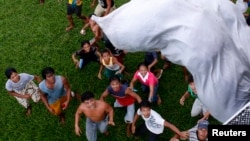With emergency aid now flowing to most of the worst-hit areas of the central Philippines, relief groups say the biggest challenge will be to provide longer-term help to the millions affected by Typhoon Haiyan.
It has now been nearly two weeks since one of the strongest storms ever to hit land wiped out entire villages with its powerful winds and a tsunami-like storm surge. Although initial aid flow was slow, basic supplies are now available for most of those in need.
VOA's Steve Herman has been reporting from Leyte, one of the islands that received the brunt of the storm. On Thursday, he spoke with Jennifer Hardy of Catholic Relief Services, who said many survivors are optimistic, despite the hardships that remain.
"Catholic Relief Services did our first distribution in San Joaqin Parish here on the church grounds today, and I heard a lot of hopeful words after that, like 'Now we have something," she said. "Now we won't get wet tonight when we're sleeping.' And there was kind of a change in attitude as people were talking."
But the gravity of the situation is never far away. On the same church grounds where relief goods were being distributed, at least 250 bodies have been buried.
"We are at the site of a mass grave, so I think the reality of the situation has sunk in to some extent," Hardy said. "But what is still to be determined is how long this recovery effort will take. And that's what I think people, as they go through day by day, they'll be wondering why aren't things better yet."
Hardy added that aid groups and government agencies are working hard to deliver the right emergency food and shelter to the right people as quickly as possible. But she stressed that the biggest need may be yet to come.
"Right now it's emergency shelter," she said. "So these are supposed to be short-term solutions, and now it's going to be a huge need for longer-term - what are going to be more permanent solutions, or at least transitional solutions for people."
These solutions include shelter that goes beyond the tarps and tents given to many of the hundreds of thousands displaced. It also includes addressing long-term food security issues for areas that have had their crops destroyed.
Hardy said she has been "amazed at the outpouring of generosity" from the international community, and that Filipinos she has met have also been grateful for the international aid they have received.
But groups such as Catholic Relief Services, as well as the United Nations, are warning that the crisis is not over. They say there will be a need for continued generosity once the storm and its aftermath fade from the international headlines.
It has now been nearly two weeks since one of the strongest storms ever to hit land wiped out entire villages with its powerful winds and a tsunami-like storm surge. Although initial aid flow was slow, basic supplies are now available for most of those in need.
VOA's Steve Herman has been reporting from Leyte, one of the islands that received the brunt of the storm. On Thursday, he spoke with Jennifer Hardy of Catholic Relief Services, who said many survivors are optimistic, despite the hardships that remain.
"Catholic Relief Services did our first distribution in San Joaqin Parish here on the church grounds today, and I heard a lot of hopeful words after that, like 'Now we have something," she said. "Now we won't get wet tonight when we're sleeping.' And there was kind of a change in attitude as people were talking."
But the gravity of the situation is never far away. On the same church grounds where relief goods were being distributed, at least 250 bodies have been buried.
"We are at the site of a mass grave, so I think the reality of the situation has sunk in to some extent," Hardy said. "But what is still to be determined is how long this recovery effort will take. And that's what I think people, as they go through day by day, they'll be wondering why aren't things better yet."
Hardy added that aid groups and government agencies are working hard to deliver the right emergency food and shelter to the right people as quickly as possible. But she stressed that the biggest need may be yet to come.
"Right now it's emergency shelter," she said. "So these are supposed to be short-term solutions, and now it's going to be a huge need for longer-term - what are going to be more permanent solutions, or at least transitional solutions for people."
These solutions include shelter that goes beyond the tarps and tents given to many of the hundreds of thousands displaced. It also includes addressing long-term food security issues for areas that have had their crops destroyed.
Hardy said she has been "amazed at the outpouring of generosity" from the international community, and that Filipinos she has met have also been grateful for the international aid they have received.
But groups such as Catholic Relief Services, as well as the United Nations, are warning that the crisis is not over. They say there will be a need for continued generosity once the storm and its aftermath fade from the international headlines.













